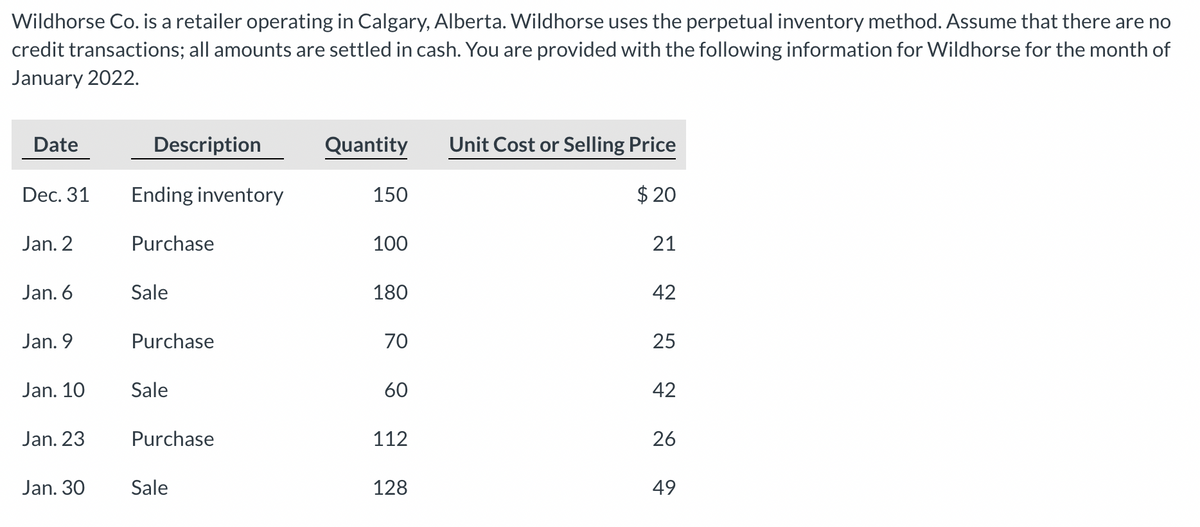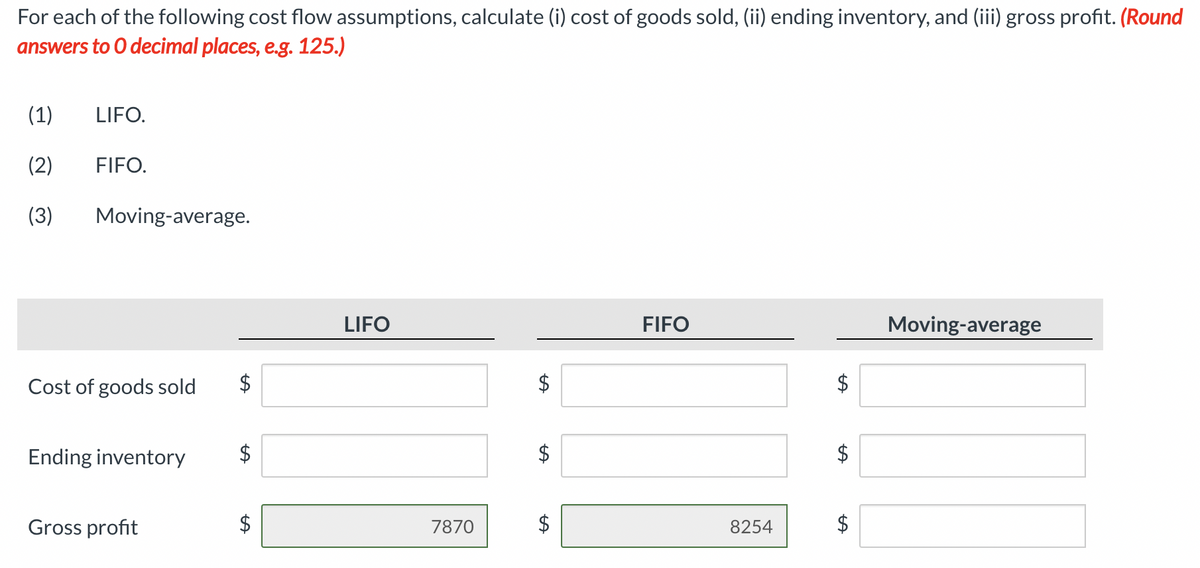Wildhorse Co. is a retailer operating in Calgary, Alberta. Wildhorse uses the perpetual inventory method. Assume that there are no credit transactions; all amounts are settled in cash. You are provided with the following information for Wildhorse for the month of January 2022. Date Description Quantity Unit Cost or Selling Price Dec. 31 Ending inventory 150 $ 20 Jan. 2 Purchase 100 21 Jan. 6 Sale 180 42 Jan. 9 Purchase 70 25 Jan. 10 Sale 60 42 Jan. 23 Purchase 112 26 Jan. 30 Sale 128 49
Wildhorse Co. is a retailer operating in Calgary, Alberta. Wildhorse uses the perpetual inventory method. Assume that there are no credit transactions; all amounts are settled in cash. You are provided with the following information for Wildhorse for the month of January 2022. Date Description Quantity Unit Cost or Selling Price Dec. 31 Ending inventory 150 $ 20 Jan. 2 Purchase 100 21 Jan. 6 Sale 180 42 Jan. 9 Purchase 70 25 Jan. 10 Sale 60 42 Jan. 23 Purchase 112 26 Jan. 30 Sale 128 49
Intermediate Accounting: Reporting And Analysis
3rd Edition
ISBN:9781337788281
Author:James M. Wahlen, Jefferson P. Jones, Donald Pagach
Publisher:James M. Wahlen, Jefferson P. Jones, Donald Pagach
Chapter7: Inventories: Cost Measurement And Flow Assumptions
Section: Chapter Questions
Problem 11RE: Jessie Stores uses the periodic system of calculating inventory. The following information is...
Related questions
Question
CALCULATE IT VIA ONLYFIFO AND MOVING AVERAGE IGNORE LIFO
PLEASE DO NOT GIVE ANSWER FROM OTHER PLATFORM

Transcribed Image Text:Wildhorse Co. is a retailer operating in Calgary, Alberta. Wildhorse uses the perpetual inventory method. Assume that there are no
credit transactions; all amounts are settled in cash. You are provided with the following information for Wildhorse for the month of
January 2022.
Date
Description
Quantity
Unit Cost or Selling Price
Dec. 31
Ending inventory
150
$ 20
Jan. 2
Purchase
100
21
Jan. 6
Sale
180
42
Jan. 9
Purchase
70
25
Jan. 10
Sale
60
42
Jan. 23
Purchase
112
26
Jan. 30
Sale
128
49

Transcribed Image Text:For each of the following cost flow assumptions, calculate (i) cost of goods sold, (ii) ending inventory, and (iii) gross profit. (Round
answers to 0 decimal places, e.g. 125.)
(1)
LIFO.
(2)
FIFO.
(3)
Moving-average.
LIFO
FIFO
Moving-average
Cost of goods sold
Ending inventory
$
Gross profit
7870
8254
%24
%24
%24
%24
%24
%24
%24
Expert Solution
This question has been solved!
Explore an expertly crafted, step-by-step solution for a thorough understanding of key concepts.
This is a popular solution!
Trending now
This is a popular solution!
Step by step
Solved in 3 steps

Recommended textbooks for you

Intermediate Accounting: Reporting And Analysis
Accounting
ISBN:
9781337788281
Author:
James M. Wahlen, Jefferson P. Jones, Donald Pagach
Publisher:
Cengage Learning

Cornerstones of Financial Accounting
Accounting
ISBN:
9781337690881
Author:
Jay Rich, Jeff Jones
Publisher:
Cengage Learning

Financial Accounting
Accounting
ISBN:
9781305088436
Author:
Carl Warren, Jim Reeve, Jonathan Duchac
Publisher:
Cengage Learning

Intermediate Accounting: Reporting And Analysis
Accounting
ISBN:
9781337788281
Author:
James M. Wahlen, Jefferson P. Jones, Donald Pagach
Publisher:
Cengage Learning

Cornerstones of Financial Accounting
Accounting
ISBN:
9781337690881
Author:
Jay Rich, Jeff Jones
Publisher:
Cengage Learning

Financial Accounting
Accounting
ISBN:
9781305088436
Author:
Carl Warren, Jim Reeve, Jonathan Duchac
Publisher:
Cengage Learning

College Accounting (Book Only): A Career Approach
Accounting
ISBN:
9781337280570
Author:
Scott, Cathy J.
Publisher:
South-Western College Pub

Financial Accounting
Accounting
ISBN:
9781337272124
Author:
Carl Warren, James M. Reeve, Jonathan Duchac
Publisher:
Cengage Learning

Individual Income Taxes
Accounting
ISBN:
9780357109731
Author:
Hoffman
Publisher:
CENGAGE LEARNING - CONSIGNMENT